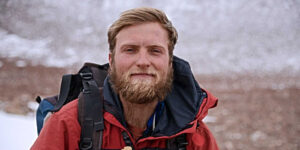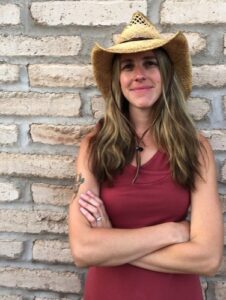Greenland was ice-free not long ago, and could be going there again. New revelations from Dr. Andrew Christ University of Vermont. Super-scientist Jessica Tierney explains why the worst scenarios for climate change may not happen. Real news, real climate right here on Radio Ecoshock.
Listen to/download this Radio Ecoshock show in CD Quality (57 MB) or Lo-Fi (14 MB)
GREENLAND MELT – ANDREW CHRIST
Everything is changing so fast. But this may be the final straw: even Greenland, frozen Greenland with ice a mile thick, is transitory. In this second year of the pandemic, scientists discover Greenland was actually green with plants, and not that long ago. Is that where this is going now?
The lead author of the new paper in PNAS is Andrew J. Christ, the Gund Postdoctoral Fellow & Lecturer in the Department of Geology at the University of Vermont. Examining a drill core collected during the Cold War and forgotten for almost 60 years, Christ and his Vermont Colleague Paul Bierman found evidence of plant life from less than a million years ago.

Andrew “Drew” Christ, University of Vermont
Listen to or download this 29 minute interview with Andrew Christ in CD Quality or Lo-Fi
Or watch the video interview with Drew Christ on YouTube
In a 2019 paper, Drew Christ and Vermont colleague Paul Bierman published a paper titled “The Northwestern Greenland Ice Sheet During The Early Pleistocene Was Similar To Today”. While that remain true, the pair did not realize the massive glacier covering Greenland had melted away in the intervening years. The whole of Greenland was not ice-free. There were still snow-capped mountains with small local glaciers in that warming period. But most of the continent was green and not white.
Obviously that changes everything. Green plants absorb and capture carbon, instead of bouncing sunlight back into space as white glaciers do. When the ice disappears due to warming, it becomes a feedback effect, adding more warming. As Drew points out, when the glaciers retreat this time, whatever grows on Greenland will also change the carbon balance of the world. Past fossil and micro-sampling evidence shows southern Greenland once hosted great Boreal forests, while the northern parts were more like the Canadian Tundra.
As you can see by the right-hand map above, the topography of Greenland is now what you might expect. Below the ice is a huge depression where land is below sea level. This would fill in to become a somewhat salty inland sea, scientists think. But even that would not last over geologic time. When the weight of the glaciers is removed, the land will begin to rise again.
Some amazing science went into this new paper from Christ et al. For example, they took some of the bottom ice and soil to a specialized lab that can measure the escape of cosmological rays. When land is exposed to the atmosphere, cosmic rays (energy from outer space) bombards it and some is captured. That remained during perhaps a million years under the deep ice. Scientists can measure when that cosmic energy when it escapes from their samples. That tells us if that material has been on the surface, and approximately how long ago. A particle accelerator is involved.
If Greenland melts, global sea levels would go up several meters. All coastal maps would be redrawn and most coastal cities would go under the waves. Weather systems in the Northern Hemisphere would be disrupted. As Drew says, we are doing things in decades that used to take hundreds of thousands of years to occur. He continues “we are going into uncharted territory where most disruptive events can happen”. This process can be slowed down by drastically cutting our greenhouse gas emissions. But nobody knows if the big Greenland melt can be stopped now that it has begun.
I talk to a lot of good scientists. They pass on frightening possibilities about the future as we alter the climate. But for some reason, this study seems particularly destabilizing. Greenland covered in ice is supposed to be one thing we can count on. After the thrill of making this discovery, these New England scientists also felt the danger revealed in this news.
The paper “A multimillion-year-old record of Greenland vegetation and glacial history preserved in sediment beneath 1.4 km of ice at Camp Century” was published in the Proceedings of the National Academy of Sciences on March 30, 2021.
————————————————————————————————————————————–
MORE PRESS COVERAGE OF THIS PAPER
Scientists Stunned to Discover Plants Beneath Mile-Deep Greenland Ice – Why This Spells Trouble
A forgotten Cold War experiment has revealed its icy secret. It’s bad news for the planet. (Washington Post, excellent but Paywall after a few reads).
Ancient leaves preserved under a mile of Greenland’s ice – and lost in a freezer for years – hold lessons about climate change
March 15, 2021 (article by Drew Christ and Paul Bierman, with good photos)
Plus, check out more new science on the time 125,000 years ago when the Arctic was green with shrubs growing right up to the Canadian Arctic Ocean shores: “Ancient plant DNA reveals High Arctic greening during the Last Interglacial”, Sarah E. Crump et al, Proceedings of the National Academy of Sciences (2021). DOI: 10.1073/pnas.2019069118
=====================================================================================
HOW BAD WILL IT BE? JESSICA TIERNEY
Hopefully top climate negotiators for 197 member countries will meet in Glasgow to figure out our climate future. They have new data from over 40 world-class climate models revealing Earth could get much hotter. Without fast broad action to reduce emissions, new model runs suggest the planet could surpass 5 degrees C of global warming. That is disaster for currently living things including humans. But is there a flaw in the latest models?
Our guest Dr. Jessica Tierney calls on records of past climates to say we may be overestimating warming. With her specialty in Paleoclimatology and Organic Geochemistry, in the last three years Tierney has led or co-authored dozens of peer-reviewed papers explaining how the deep past can help project our future.

Dr. Jennifer Tierney, University of Arizona
Listen to or download this 29 minute interview with Jessica Tierney in CD Quality or Lo-Fi
A YouTube version of this interview with Jessica Tierney should be out in the next week or two.
As citizens on Earth, we need to understand what top climate negotiators for governments, like John Kerry for the United States, will be told by scientists, before agreements on what to do about climate change. Where do the projections for what could happen come from? The latest climate scenarios come not from one source, but a collection of leading climate computation centers. This effort has been going on for years, and now we have “CMIP6, The Coupled Model Intercomparison Project.
SAY GOODBYE TO RCP PATHWAYS, and HELLO TO “Shared Socioeconomic Pathways” (SSPs).
Before we get to your objections to the worst-case 5.7 degrees warming in the new models, I have to tell regular listeners the old RCP system, Representative Concentration Pathways used by the Intergovernmental Panel on Climate Change – has been dumped. The public was barely learning about RCP8.5 and now that’s out. Now scientists use “Shared Socioeconomic Pathways” (SSPs).
As Jessica explains in the interview, the change is not that big. It still contains the minimum climate warming we can hope for, and the most extreme (actually even hotter). But new steps in between help refine the process of setting goals and expectations.
Jennifer says new CMIP6 models exaggerate the cold when trying to reconstruct climate during the Last Glacial Maximum, just 22,000 years ago. They show about 11 degrees C of colder global temperatures, when the reality was almost half that, about 6 degrees C colder. If the latest models cannot accurately predict the past, perhaps they are also exaggerating (a little) the highest possible temperatures in the future. Scientists are still working on how to get Earth’s Climate Sensitivity right – the amount of warming expected when carbon dioxide levels in the atmosphere reach double what they were before industrial times.
Again, amazing science is at work here. Jennifer’s lab works with molecular fossils. That’s right, even molecules can be preserved as fossils. For example, the search for a fat produced by algae long ago. That reflects the water temperature when the fat was made. It is a temperature gauge for past ages.
A wide group of scientists, including Mark D Zelinka and Tierney’s whole team, say CMIP6 models get the glacial past wrong because of assumptions about clouds. This goes again to the formation of low-lying cloud banks, stratus clouds, that form near the sea. It’s a deep dive discussion to figure out how they work in the past, and in our hotter future. In April 2019, I interviewed Tapio Schnieider from NASA whose work showed there is a threshold above 1200 parts per million CO2 where those cloud banks could NOT form. At that point, Earth would warm up to 8 degrees C. (14 F) above whatever global warming we already created! But in the case Tierney and others are examining, they consider the formation of clouds when Earth was much colder and glaciers covered a lot of the Northern Hemisphere.
In the interview, I ask Jennifer: Is the energy required to thaw polar ice, like Greenland glacier, acting as a brake on climate change, slowing down or almost hiding the true energy imbalance we have created with greenhouse gases? If so, when a lot of polar ice disappears, could Earth then jump up to the real heat created? That is likely true.
Despite doubts about some aspects of CMIP6 high-end projection, Jessica Tierney is lead author on one of the most important projects in the upcoming Intergovernmental Panel on Climate Change (IPCC) Sixth Assessment report. For the first time, there will be a chapter on drought and extreme precipitation events. That is key as both events are already striking all over the world causing major damage and loss of life. I look forward to talking with Jennifer about that report when it comes out, likely in January 2022.
The use of paleo-climate data in climate models is not easy for the public to understand. But this latest paper from Tierney et al suggests slightly less harsh news about our projected future. It is possible cloud modeling errors make the upper limits of heating (by year 2100) too high, at 5.7 degree C of warming. Just three of four degrees of warming would be devastating for civilization, but I suppose not going to 5.7 C hotter is good news. We have to take good news where we can find it these days.
This interview with Jennifer Tierney is based on the paper “Assessment of Equilibrium Climate Sensitivity of the Community Earth System Model Version 2 Through Simulation of the Last Glacial Maximum” as published in Geophysical Research Letters 12 January 2021. It is Open Access, so you can read it for yourself.
SEE ALSO: “Past climates inform our future” led by J. Tierney, published in Science 2020, and this article about the new paper in Phys.org.
SEE ALSO THESE DOUBTS ABOUT THE LATEST MODEL
“Some of the newest models used to make future predictions may be too sensitive to increases in atmospheric carbon dioxide and thus predict too much warming,” said U-M’s Chris Poulsen, a professor in the U-M Department of Earth and Environmental Sciences and one of the study’s three authors.
=======================================================================================
SHOW NOTES
Please tell everyone about this program. You as a listener are the official show outreach agent. Please cross-post, Tweet about and Facebook about this show and blog. We need to educate the world.
Follow Radio Ecoshock on Twitter @ecoshock on Facebook (thanks to long-standing helper Jackie!) and subscribe on YouTube (that helps more Google searches find the show). The YouTube channel is: https://www.youtube.com/channel/UC65sMyr2LMSdO5qVzV3biTQ
I also continue to need financial support. I know it is boring to hear me say that every week. But I am pouring everything I have into finding the most important science news along with activist ideas. It costs money to produce and distribute this program. It goes out free to everyone, including all the 105 non-profit radio stations. Don’t even think about sending a donation if you are out of work or tight for money. But if you can afford to help, please make a donation using this page.
By the way, I don’t use Patreon because I have no time to send out gifts and incentives. Paypal, for all its faults (the founders are not political good guys) – makes it easy for me, and removes the need to hire a book keeper at tax time. If Paypal doesn’t work for you, please send a postal money order or bank check to the mail address provided. Any donation by check should be about $20 US or more to cover the charges from banks to process it. Anyway, I appreciate all the good people who help this global conversation keep going. Thank you!
Tune in again next week for more great guests! Thank you for listening, and caring about our world.

Alex Smith, host of Radio Ecoshock
Tierney is saying models have had too high a sensitivity number for doubling of GHGs (I assume she’s inclding co2 equivalents but maybe not). She sounds like she’s trying to make a name for herself by deflating the climate crisis. Would have liked to challenge her with Wasdell’s epic effort to model all factors affecting earth climate sensitivity, which was about 10dC of average warming for a doubling of co2. Moreover, we should be challenging the artificial limits of 2100 and a mere doubling of co2e. And finally addressing the Garrett Relation and the hydrological cycle (Jehne) being orders of magnitude more important than co2.